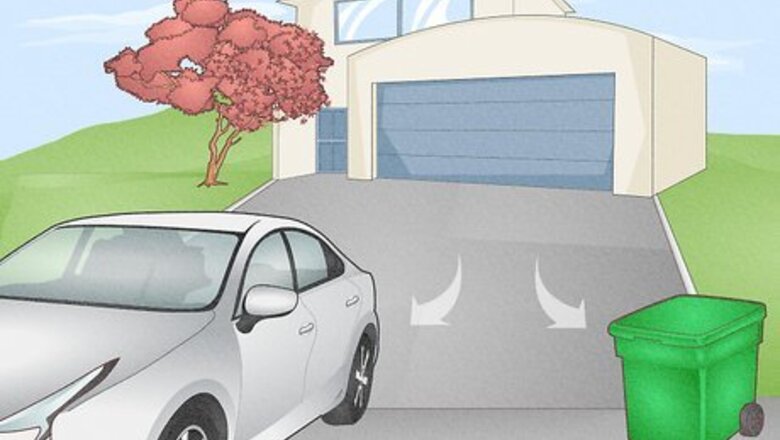
views
Using a Pressure Washer

Clear out your driveway. Remove any loose materials, cars, dirt, or stone from your driveway. If your driveway touches any doors or walls, cover them with cardboard, a tarp, or some painter's tape. This will protect them from any debris that may fly around while you are pressure washing. Check to see which end of your driveway is the highest and what direction the water will flow while you are washing. Create a dam to manage the drainage. It is best if your water is absorbed by your lawn. If the water drains into a storm drain, you will be introducing chemicals into your local water supply.

Apply a degreaser to the stain. Oil and antifreeze stains are the stains you will most likely have on your driveway. Before you use a pressure washer, apply a degreaser to the stain. Allow the degreaser to sit on the stain for a few hours to soak up the stain, then reapply. Use the degreaser at full strength for older stains that have penetrated your driveway. Dilute the degreaser with water for newer stains. Follow the dilution instructions on the degreaser bottle. The dilution ratio will vary depending on the product that you use. Once you have allowed the degreaser to sit, scrub it into the stain using a wire brush.
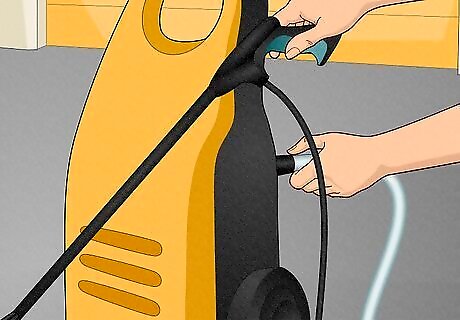
Set up your pressure washer. Typically you will use a pressure hose to connect the spray wand to the washer and connect the washer to a garden hose. The setup may vary depending on the pressure washer that you are using. Always read the instructions before you set up the pressure washer. The pressure washer comes with both low pressure and high pressure nozzles. If your cleaning a brick driveway, do not use the high pressure nozzle at all except on very stubborn stains.
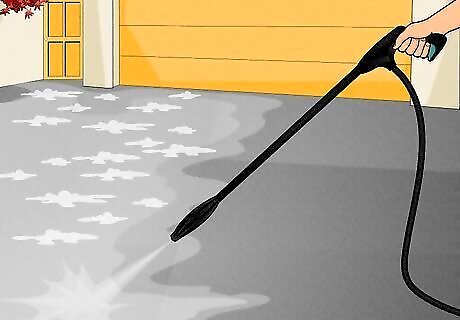
Apply the detergent to your driveway. The instructions that come with your pressure washer will tell you what type of detergent you should use. Only use detergents that have been formulated to use with a pressure washer. Use the low pressure nozzle to apply the detergent to your driveway. Point the nozzle downward and move back and forth over your driveway. Allow the detergent to sit on your driveway for 15 minutes. Do not allow the detergent to dry on your driveway. If you notice that is getting dried out, apply some water to your driveway. Do not add bleach to your pressure washer because the bleach may cause damage to the washer. Start at the higher end of the driveway and move in the direction that water flows.
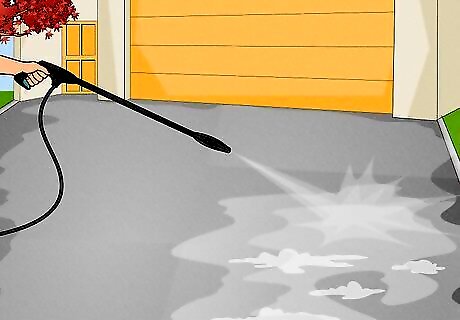
Rinse your driveway. After fifteen minutes, use the high pressure nozzle to wash away the detergent. Make sure you set the pressure washer to rinse mode. Use the same pattern you used when you were applying the detergent. Be sure to wash away all of the detergent. Pay extra attention to the heavily stained, dirtier areas of your driveway, which may require higher pressure. You can use a surface cleaner attachment for more effective cleaning. If you use this attachment, do a final rinse without the attachment one all of the detergent and dirt are gone.
Using Household Products

Apply a natural absorbent. Cat litter, corn starch, cornmeal, or baking soda be used to remove oil and gasoline from your driveway. Cover the stain with one of these products and allow it to sit for at least an hour. If the stain was wet when you applied the absorbent, the absorbent will soak up the oil or gasoline. Use a broom to sweep up the absorbent. If the stain was dry when you applied the absorbent, wet the stain with water and scrub it with a stiff brush and a paste (i.e. 3 parts baking soda to 1 part water). Then rinse the area with water and let it air dry. You may have to repeat this process more than once.
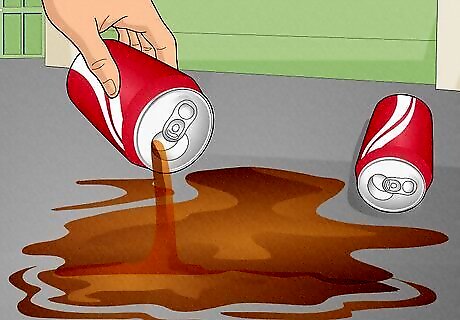
Apply cola to the stain. Pour two cans of room temperature cola on the stain and let it sit overnight. Blot the stain with a towel in the morning and rinse the stain with water. It is best to rinse the area with a hose so that you can apply pressure to the area. You can also scrub the cola into the stain with a stiff brush. If you cannot let the cola sit overnight, let it soak for at least an hour before you spray the area with water.
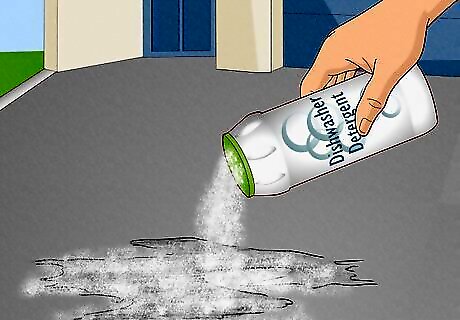
Use dishwasher detergent. Wet the area with the stain and sprinkle dish-washing detergent (i.e. powdered detergent) all over. Make sure the area is completely covered with detergent. While the detergent is sitting on the stain, boil a large pot of water. Once the water begins to boil, pour it over the stain and scrub it with a stiff-bristled brush. Rinse the area with water once you are finished. You can use baking soda instead of dish-washing detergent. Repeat this process as many times as you need to.
Cleaning with Chemicals
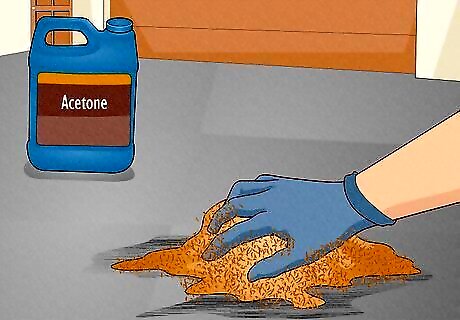
Make a poultice. Combine an absorbent material (e.g. kitty litter or sawdust) with a solvent (e.g. acetone, xylene, or lacquer thinner) until the paste has the consistency of peanut butter. Spread the poultice over the stained area. It should be 1/4 to 1/2 inch thick. Cover the area with plastic and let it sit for approximately 24 hours. The solvent will break down the oil and the absorbent will suck the oil out of the driveway. This can be an expensive option if you have a large are to cover with the poultice. Use other methods before you try a poultice or any other chemical cleaner. Always wear gloves and protective eye wear if you are working with chemicals.
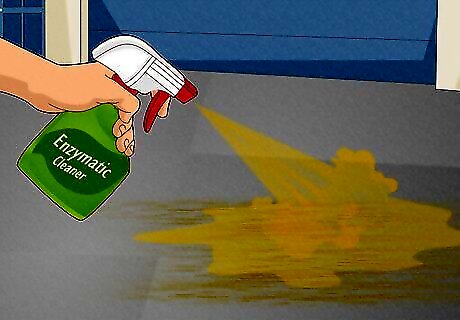
Use an enzymatic cleaner. These cleaners are also known as oxidation cleaners. You can purchase them at your local hardware store, home-improvement store, or a janitorial supply store. These chemicals do not require much work. All you have to do is apply them to the stain and let them work. No water or scrubbing is required with these cleaners. The enzymes and/or bacteria in the cleaner will destroy the stain. Always follow the instructions that come with the cleaner that you purchase. These cleaners usually take days or weeks to remove the stain. You may have to reapply for larger stains. A cleaner like this is great for removing pet urine stains.
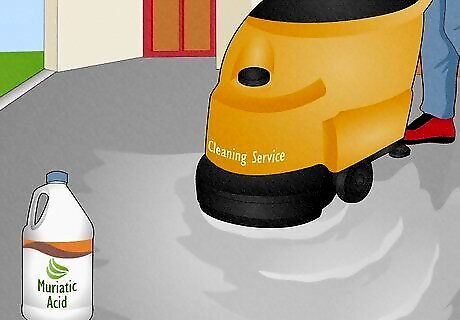
Use a professional cleaner. If all else has failed, consult a professional cleaner to treat your driveway. A professional may use muriatic acid or some other chemicals to clean your driveway. A professional can also seal your driveway to protect it from future spills, dirt and other damage. Shop around for a good price before you choose a professional. This is a more expensive option, but it can save you money in the long run.


















Comments
0 comment